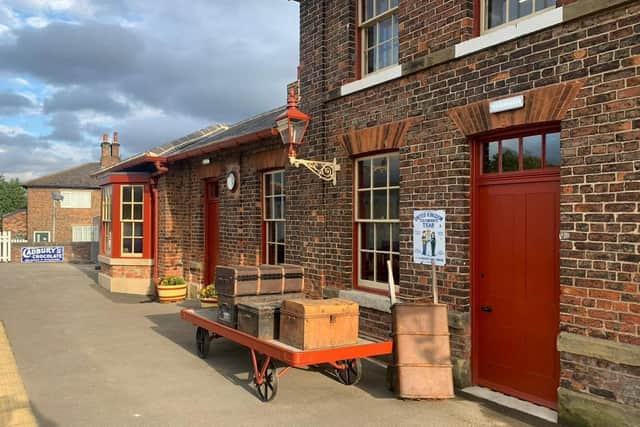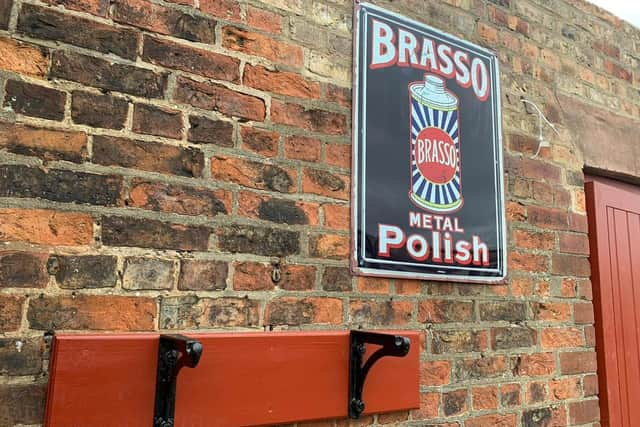Vintage signs stolen from two restored heritage stations on the Wensleydale Railway
The Grade II-listed station house is set to open to passengers for the first time since 1954 later this month and volunteers have been busy returning it to its 1920s heyday.
Although trains have called at Leeming Bar since 2003, the buildings themselves were used as offices and were not accessible to the public before the restoration project.
Advertisement
Hide AdAdvertisement
Hide AdThe signs advertised well-known 1920s brands such as Brooke Bond tea and Brasso polish.


Edwardian-themed Scruton Station, the next stop on the line, was also targeted.
The Wensleydale Railway said: "Unfortunately whilst we have been working hard to get the Grade II-listed station house at Leeming Bar ready for our Grand Opening on Monday we have had some signs stolen from both Leeming and Scruton stations. A couple were replicas but we have also had a genuine Brooke Bond Tea sign stolen.
"If you come across any of these signs please let us know.


If you have any information contact North Yorkshire Police on 101 and quote 12220075674.
Advertisement
Hide AdAdvertisement
Hide AdThe restoration of Leeming Bar has seen the parcels office, ticket office, waiting room and stationmaster's private accommodation all refurbished.
The long-running project, propped up by the hard work of volunteers, has even seen them track down original parts of the station apparatus that were thought to have been lost forever.
After the Wensleydale Railway successfully restored Scruton Station to its Edwardian, turn-of-the-century glory, they settled on the period immediately following World War One for Leeming Bar - though as community engagement officer Will Burnham points out, the roaring 1920s didn't shout too loudly in the rural Dales.
"The station has changed massively. Leeming Bar was tumbledown and in danger of falling to pieces. It was an admin hub of the railway, with offices for staff, but it wasn't publicly accessible and it had damp, no heating and was in a really sorry state. But it has so much history and you could see the character that still seeped through.
Advertisement
Hide AdAdvertisement
Hide Ad"We picked the 1920s because it was a period of massive change for the railways, with the line becoming part of the LNER in the new groupings. In future we plan to restore more stations to reflect other periods and show the passage of time."
The parcels office would have been the hub of the station in the 1920s, when most mail travelled by train
Volunteers performed a number of roles, from the painters and decorators to the cabinet-maker in his 80s who fitted an Edwardian kitchen using techniques taught to him by a man who had learned the craft in the Victorian age.
The research group pieced together information about the stationmaster and his wife, and their story will be incorporated into the visitor experience.
Advertisement
Hide AdAdvertisement
Hide AdYet the triumphs of the 'searchers' trawling Ebay and auctioneers for period pieces includes unique finds.
They managed to acquire the original leather cash pouches that had been used by Leeming Bar staff in the 19th century from an auction house, while a brass plaque commemorating the line's opening in the 1860s was also tracked down. The county council's records office helped to restore a large map of Wensleydale that will hang in the parcels office, and the owner of Wensley Station, which has been a private residence since the line's closure, donated the building's ticket equipment.
Items from the period that came from other stations include ticket racks and labels from the late 1800s, telegraph machines, and the cast iron ticket grilles from Scruton that had been on display in a museum. Several rotten waiting benches from a station in Cumbria have been restored. Mangles, washtubs and cheese presses will be used in a functional stationmaster's kitchen, and a rare double-faced clock has been gifted.
"The parcels office is the most important room, and contains the stationmaster's desk. The ticket office will be the place where you still buy tickets today, and we have 1920s timetables on display. The waiting room has old luggage, posters and benches. These areas are what passengers in the 1920s would have seen."
Advertisement
Hide AdAdvertisement
Hide AdHowever, a century ago they would not have been granted access into the stationmaster's family's private quarters, which include a parlour with William Morris wallpaper.
"These rooms still feel very Victorian, because the roaring 1920s were happening in London, not up here!"

